Cost Forecasting in Construction Project
VerifiedAdded on 2023/06/10
|12
|2113
|336
AI Summary
This report analyzes the present scenario of a construction project in Australia by investigating different related articles. It reviews a specific article on cost forecasting and provides preliminary research questions. The article chosen discusses the structural dimension of social capital and its role in disseminating project knowledge in construction organizations in Australia. The report concludes that cost forecasting is a vital strategic task in project management and requires a formal forecasting model that uses both human perception and historical data.
Contribute Materials
Your contribution can guide someone’s learning journey. Share your
documents today.
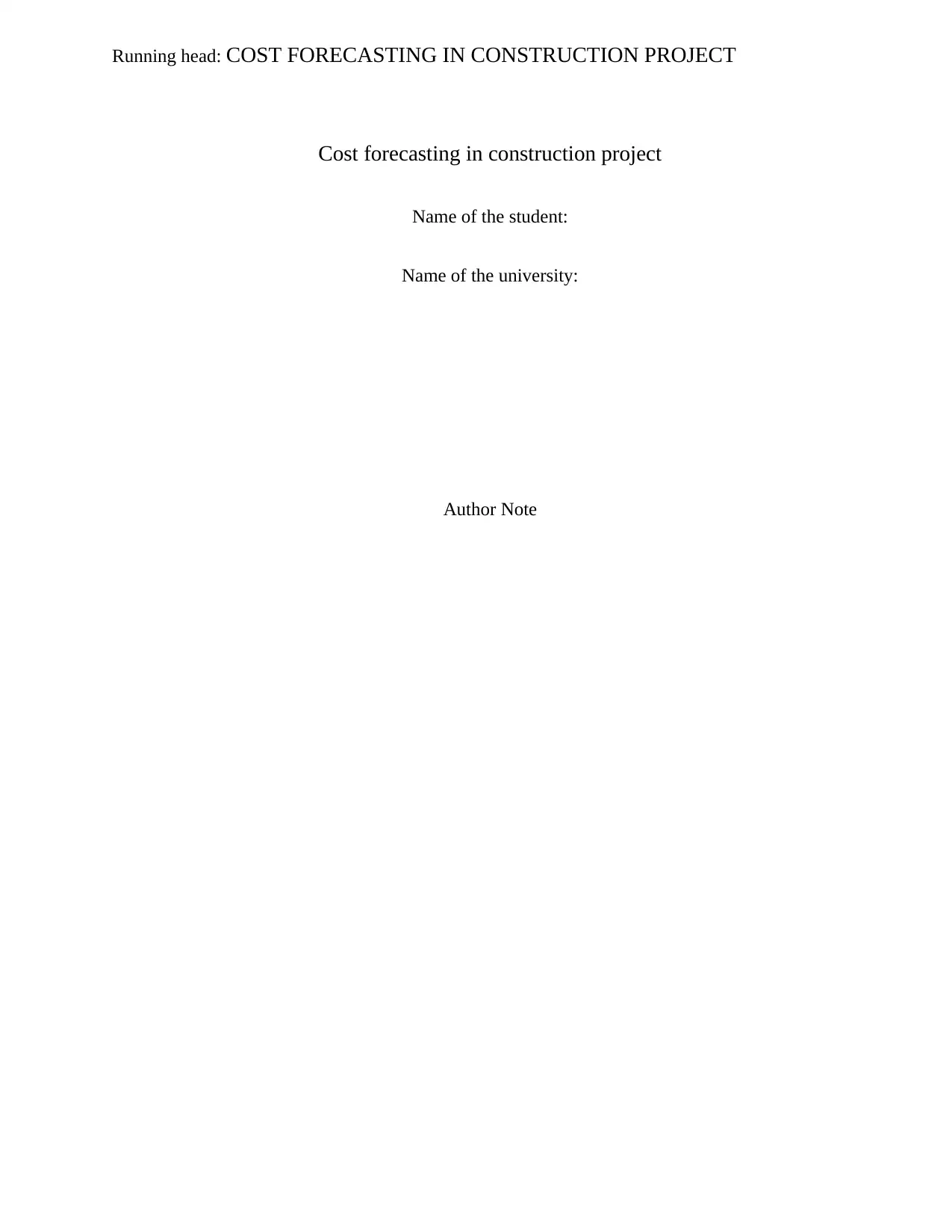
Running head: COST FORECASTING IN CONSTRUCTION PROJECT
Cost forecasting in construction project
Name of the student:
Name of the university:
Author Note
Cost forecasting in construction project
Name of the student:
Name of the university:
Author Note
Secure Best Marks with AI Grader
Need help grading? Try our AI Grader for instant feedback on your assignments.
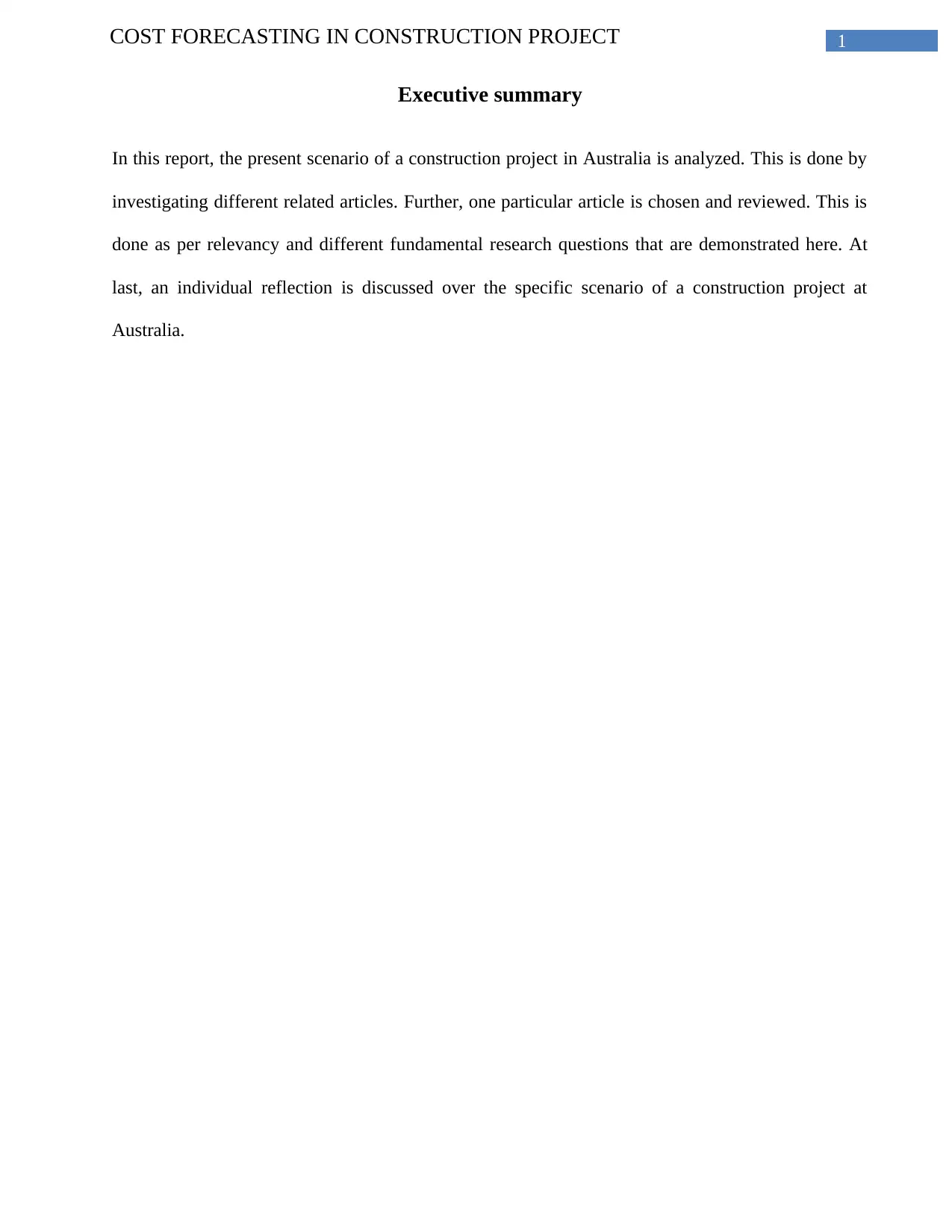
1COST FORECASTING IN CONSTRUCTION PROJECT
Executive summary
In this report, the present scenario of a construction project in Australia is analyzed. This is done by
investigating different related articles. Further, one particular article is chosen and reviewed. This is
done as per relevancy and different fundamental research questions that are demonstrated here. At
last, an individual reflection is discussed over the specific scenario of a construction project at
Australia.
Executive summary
In this report, the present scenario of a construction project in Australia is analyzed. This is done by
investigating different related articles. Further, one particular article is chosen and reviewed. This is
done as per relevancy and different fundamental research questions that are demonstrated here. At
last, an individual reflection is discussed over the specific scenario of a construction project at
Australia.
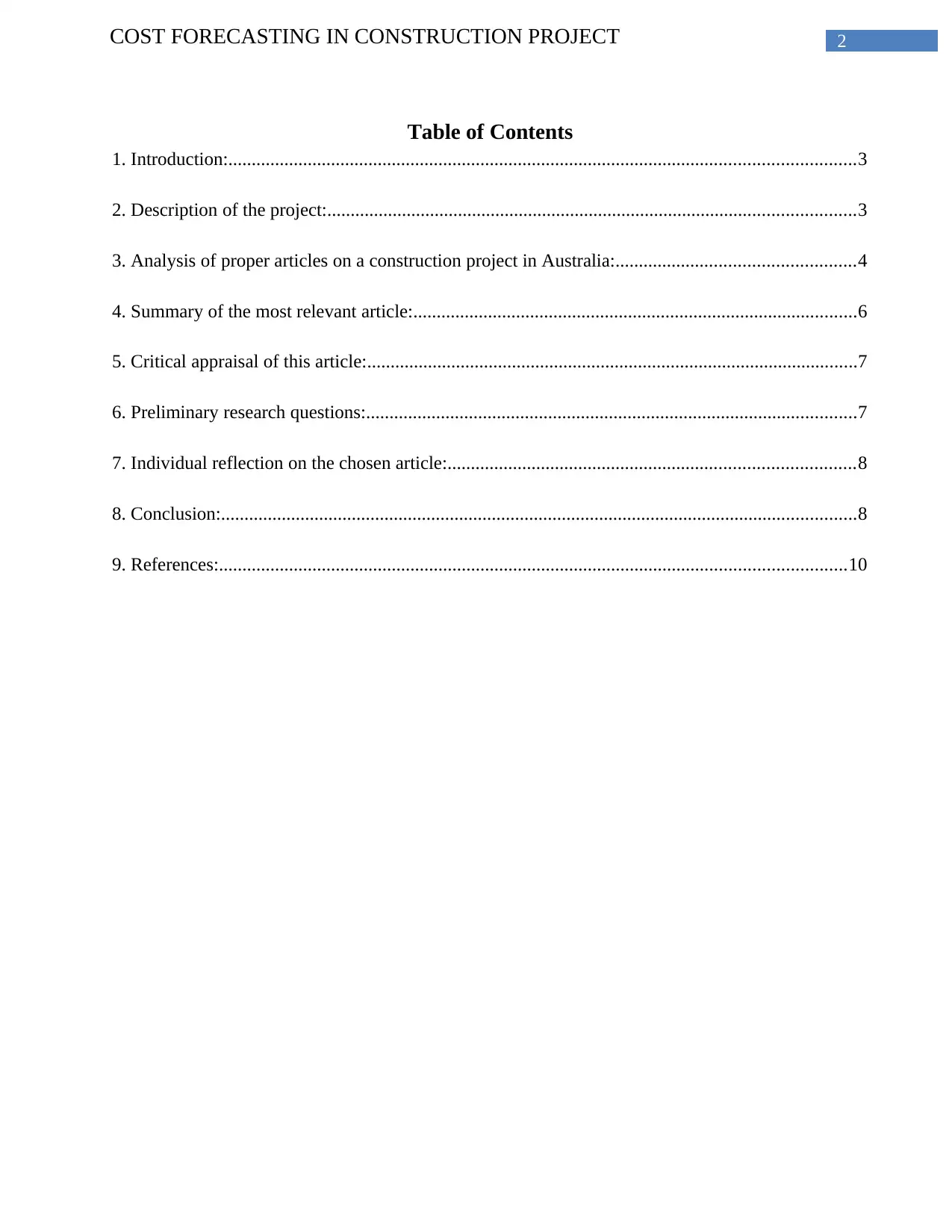
2COST FORECASTING IN CONSTRUCTION PROJECT
Table of Contents
1. Introduction:......................................................................................................................................3
2. Description of the project:.................................................................................................................3
3. Analysis of proper articles on a construction project in Australia:...................................................4
4. Summary of the most relevant article:...............................................................................................6
5. Critical appraisal of this article:.........................................................................................................7
6. Preliminary research questions:.........................................................................................................7
7. Individual reflection on the chosen article:.......................................................................................8
8. Conclusion:........................................................................................................................................8
9. References:......................................................................................................................................10
Table of Contents
1. Introduction:......................................................................................................................................3
2. Description of the project:.................................................................................................................3
3. Analysis of proper articles on a construction project in Australia:...................................................4
4. Summary of the most relevant article:...............................................................................................6
5. Critical appraisal of this article:.........................................................................................................7
6. Preliminary research questions:.........................................................................................................7
7. Individual reflection on the chosen article:.......................................................................................8
8. Conclusion:........................................................................................................................................8
9. References:......................................................................................................................................10
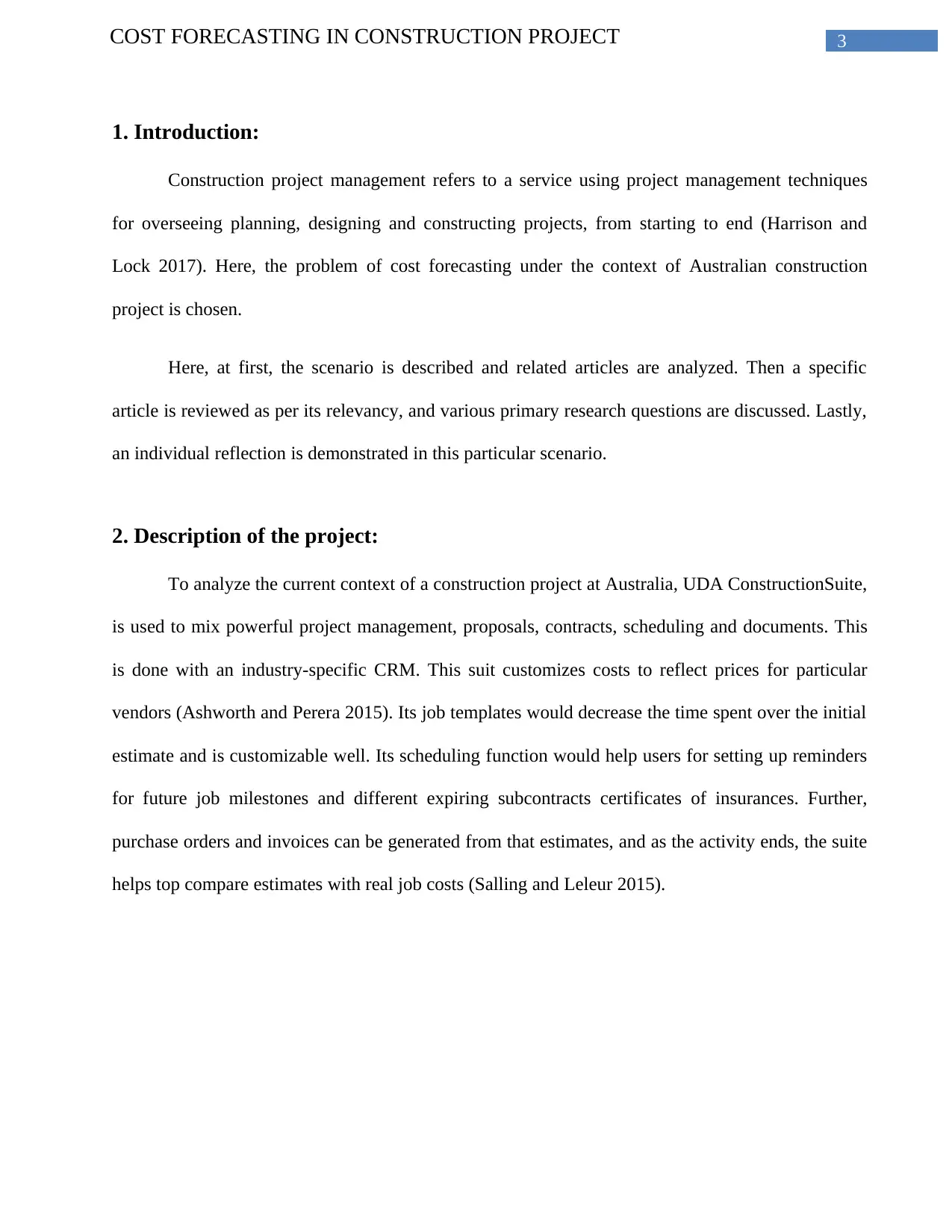
3COST FORECASTING IN CONSTRUCTION PROJECT
1. Introduction:
Construction project management refers to a service using project management techniques
for overseeing planning, designing and constructing projects, from starting to end (Harrison and
Lock 2017). Here, the problem of cost forecasting under the context of Australian construction
project is chosen.
Here, at first, the scenario is described and related articles are analyzed. Then a specific
article is reviewed as per its relevancy, and various primary research questions are discussed. Lastly,
an individual reflection is demonstrated in this particular scenario.
2. Description of the project:
To analyze the current context of a construction project at Australia, UDA ConstructionSuite,
is used to mix powerful project management, proposals, contracts, scheduling and documents. This
is done with an industry-specific CRM. This suit customizes costs to reflect prices for particular
vendors (Ashworth and Perera 2015). Its job templates would decrease the time spent over the initial
estimate and is customizable well. Its scheduling function would help users for setting up reminders
for future job milestones and different expiring subcontracts certificates of insurances. Further,
purchase orders and invoices can be generated from that estimates, and as the activity ends, the suite
helps top compare estimates with real job costs (Salling and Leleur 2015).
1. Introduction:
Construction project management refers to a service using project management techniques
for overseeing planning, designing and constructing projects, from starting to end (Harrison and
Lock 2017). Here, the problem of cost forecasting under the context of Australian construction
project is chosen.
Here, at first, the scenario is described and related articles are analyzed. Then a specific
article is reviewed as per its relevancy, and various primary research questions are discussed. Lastly,
an individual reflection is demonstrated in this particular scenario.
2. Description of the project:
To analyze the current context of a construction project at Australia, UDA ConstructionSuite,
is used to mix powerful project management, proposals, contracts, scheduling and documents. This
is done with an industry-specific CRM. This suit customizes costs to reflect prices for particular
vendors (Ashworth and Perera 2015). Its job templates would decrease the time spent over the initial
estimate and is customizable well. Its scheduling function would help users for setting up reminders
for future job milestones and different expiring subcontracts certificates of insurances. Further,
purchase orders and invoices can be generated from that estimates, and as the activity ends, the suite
helps top compare estimates with real job costs (Salling and Leleur 2015).
Secure Best Marks with AI Grader
Need help grading? Try our AI Grader for instant feedback on your assignments.
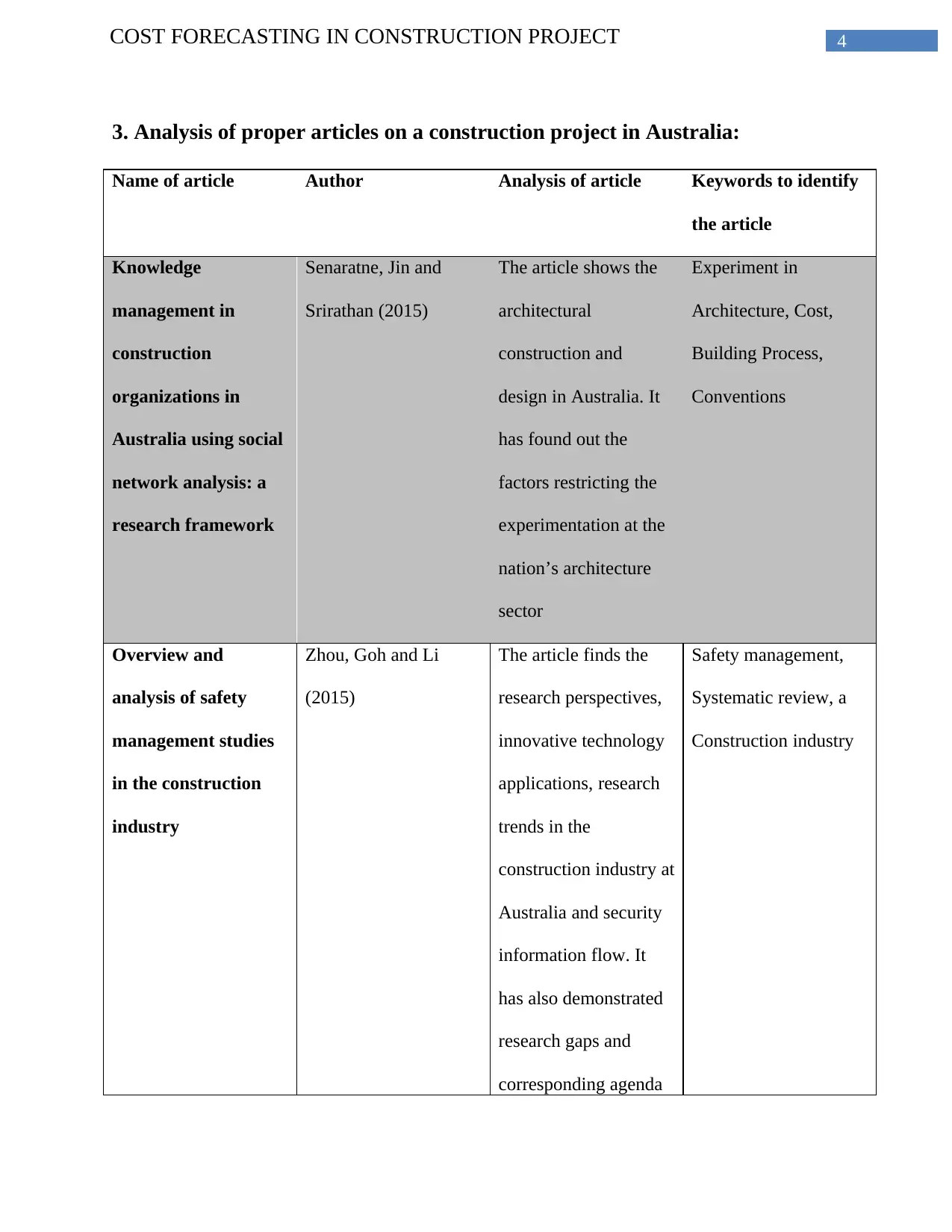
4COST FORECASTING IN CONSTRUCTION PROJECT
3. Analysis of proper articles on a construction project in Australia:
Name of article Author Analysis of article Keywords to identify
the article
Knowledge
management in
construction
organizations in
Australia using social
network analysis: a
research framework
Senaratne, Jin and
Srirathan (2015)
The article shows the
architectural
construction and
design in Australia. It
has found out the
factors restricting the
experimentation at the
nation’s architecture
sector
Experiment in
Architecture, Cost,
Building Process,
Conventions
Overview and
analysis of safety
management studies
in the construction
industry
Zhou, Goh and Li
(2015)
The article finds the
research perspectives,
innovative technology
applications, research
trends in the
construction industry at
Australia and security
information flow. It
has also demonstrated
research gaps and
corresponding agenda
Safety management,
Systematic review, a
Construction industry
3. Analysis of proper articles on a construction project in Australia:
Name of article Author Analysis of article Keywords to identify
the article
Knowledge
management in
construction
organizations in
Australia using social
network analysis: a
research framework
Senaratne, Jin and
Srirathan (2015)
The article shows the
architectural
construction and
design in Australia. It
has found out the
factors restricting the
experimentation at the
nation’s architecture
sector
Experiment in
Architecture, Cost,
Building Process,
Conventions
Overview and
analysis of safety
management studies
in the construction
industry
Zhou, Goh and Li
(2015)
The article finds the
research perspectives,
innovative technology
applications, research
trends in the
construction industry at
Australia and security
information flow. It
has also demonstrated
research gaps and
corresponding agenda
Safety management,
Systematic review, a
Construction industry
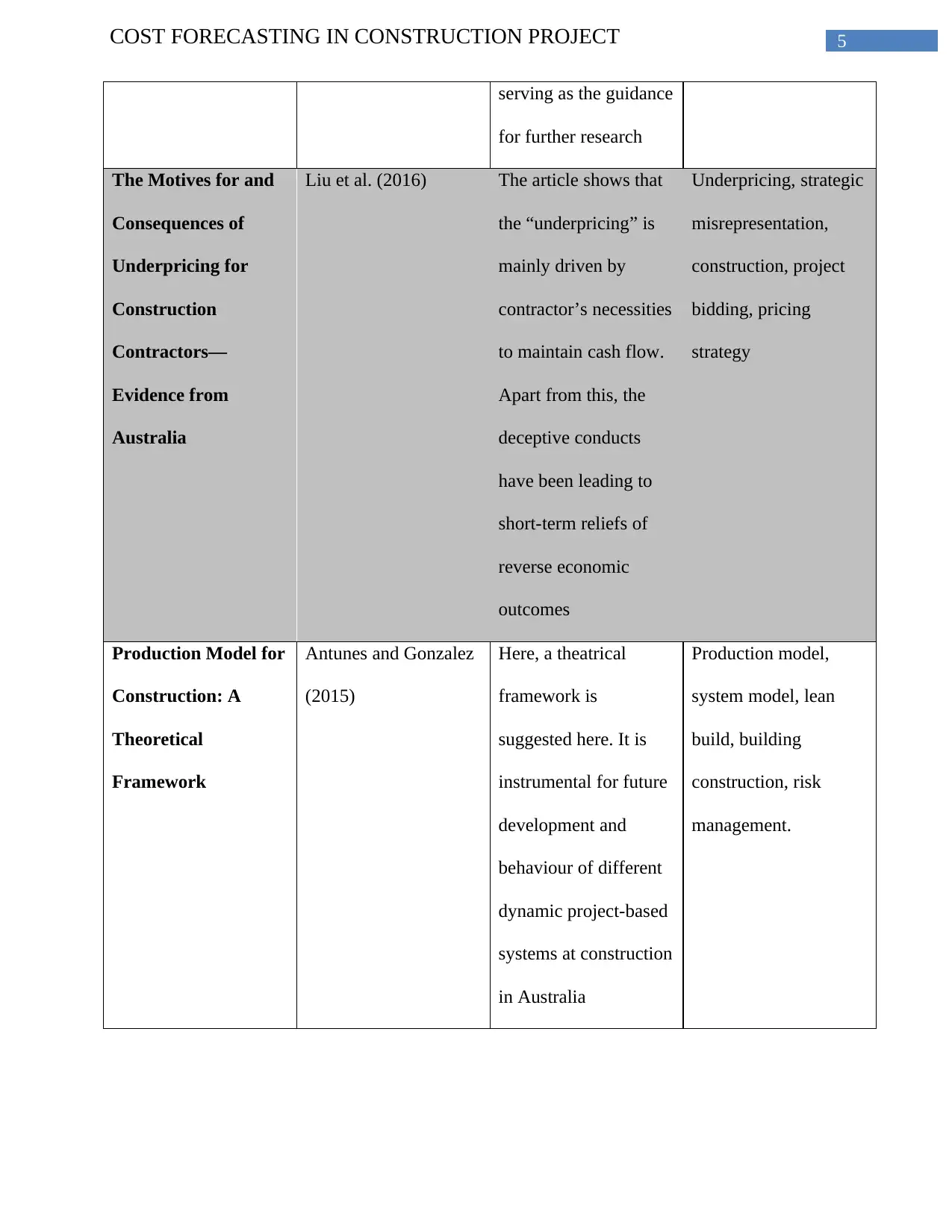
5COST FORECASTING IN CONSTRUCTION PROJECT
serving as the guidance
for further research
The Motives for and
Consequences of
Underpricing for
Construction
Contractors—
Evidence from
Australia
Liu et al. (2016) The article shows that
the “underpricing” is
mainly driven by
contractor’s necessities
to maintain cash flow.
Apart from this, the
deceptive conducts
have been leading to
short-term reliefs of
reverse economic
outcomes
Underpricing, strategic
misrepresentation,
construction, project
bidding, pricing
strategy
Production Model for
Construction: A
Theoretical
Framework
Antunes and Gonzalez
(2015)
Here, a theatrical
framework is
suggested here. It is
instrumental for future
development and
behaviour of different
dynamic project-based
systems at construction
in Australia
Production model,
system model, lean
build, building
construction, risk
management.
serving as the guidance
for further research
The Motives for and
Consequences of
Underpricing for
Construction
Contractors—
Evidence from
Australia
Liu et al. (2016) The article shows that
the “underpricing” is
mainly driven by
contractor’s necessities
to maintain cash flow.
Apart from this, the
deceptive conducts
have been leading to
short-term reliefs of
reverse economic
outcomes
Underpricing, strategic
misrepresentation,
construction, project
bidding, pricing
strategy
Production Model for
Construction: A
Theoretical
Framework
Antunes and Gonzalez
(2015)
Here, a theatrical
framework is
suggested here. It is
instrumental for future
development and
behaviour of different
dynamic project-based
systems at construction
in Australia
Production model,
system model, lean
build, building
construction, risk
management.
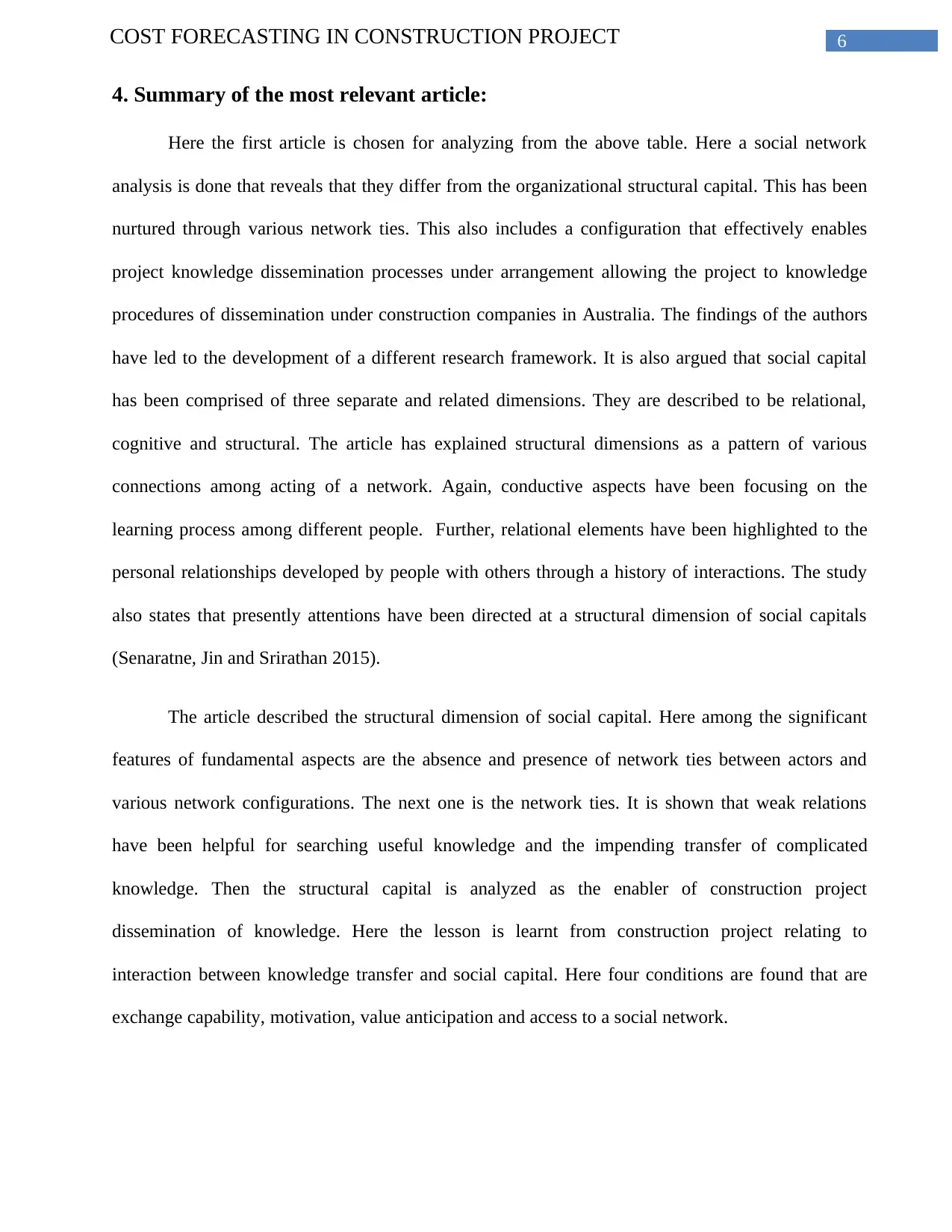
6COST FORECASTING IN CONSTRUCTION PROJECT
4. Summary of the most relevant article:
Here the first article is chosen for analyzing from the above table. Here a social network
analysis is done that reveals that they differ from the organizational structural capital. This has been
nurtured through various network ties. This also includes a configuration that effectively enables
project knowledge dissemination processes under arrangement allowing the project to knowledge
procedures of dissemination under construction companies in Australia. The findings of the authors
have led to the development of a different research framework. It is also argued that social capital
has been comprised of three separate and related dimensions. They are described to be relational,
cognitive and structural. The article has explained structural dimensions as a pattern of various
connections among acting of a network. Again, conductive aspects have been focusing on the
learning process among different people. Further, relational elements have been highlighted to the
personal relationships developed by people with others through a history of interactions. The study
also states that presently attentions have been directed at a structural dimension of social capitals
(Senaratne, Jin and Srirathan 2015).
The article described the structural dimension of social capital. Here among the significant
features of fundamental aspects are the absence and presence of network ties between actors and
various network configurations. The next one is the network ties. It is shown that weak relations
have been helpful for searching useful knowledge and the impending transfer of complicated
knowledge. Then the structural capital is analyzed as the enabler of construction project
dissemination of knowledge. Here the lesson is learnt from construction project relating to
interaction between knowledge transfer and social capital. Here four conditions are found that are
exchange capability, motivation, value anticipation and access to a social network.
4. Summary of the most relevant article:
Here the first article is chosen for analyzing from the above table. Here a social network
analysis is done that reveals that they differ from the organizational structural capital. This has been
nurtured through various network ties. This also includes a configuration that effectively enables
project knowledge dissemination processes under arrangement allowing the project to knowledge
procedures of dissemination under construction companies in Australia. The findings of the authors
have led to the development of a different research framework. It is also argued that social capital
has been comprised of three separate and related dimensions. They are described to be relational,
cognitive and structural. The article has explained structural dimensions as a pattern of various
connections among acting of a network. Again, conductive aspects have been focusing on the
learning process among different people. Further, relational elements have been highlighted to the
personal relationships developed by people with others through a history of interactions. The study
also states that presently attentions have been directed at a structural dimension of social capitals
(Senaratne, Jin and Srirathan 2015).
The article described the structural dimension of social capital. Here among the significant
features of fundamental aspects are the absence and presence of network ties between actors and
various network configurations. The next one is the network ties. It is shown that weak relations
have been helpful for searching useful knowledge and the impending transfer of complicated
knowledge. Then the structural capital is analyzed as the enabler of construction project
dissemination of knowledge. Here the lesson is learnt from construction project relating to
interaction between knowledge transfer and social capital. Here four conditions are found that are
exchange capability, motivation, value anticipation and access to a social network.
Paraphrase This Document
Need a fresh take? Get an instant paraphrase of this document with our AI Paraphraser
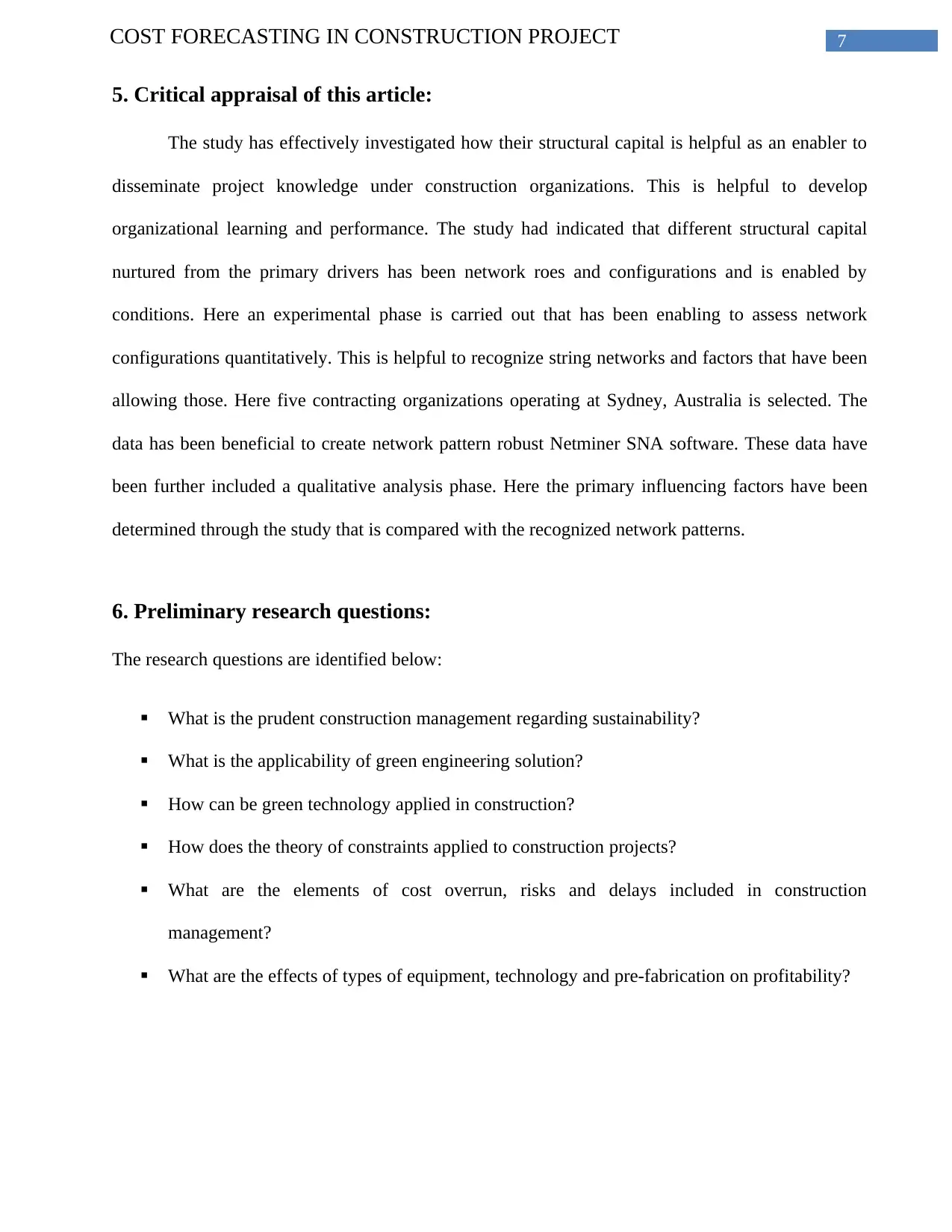
7COST FORECASTING IN CONSTRUCTION PROJECT
5. Critical appraisal of this article:
The study has effectively investigated how their structural capital is helpful as an enabler to
disseminate project knowledge under construction organizations. This is helpful to develop
organizational learning and performance. The study had indicated that different structural capital
nurtured from the primary drivers has been network roes and configurations and is enabled by
conditions. Here an experimental phase is carried out that has been enabling to assess network
configurations quantitatively. This is helpful to recognize string networks and factors that have been
allowing those. Here five contracting organizations operating at Sydney, Australia is selected. The
data has been beneficial to create network pattern robust Netminer SNA software. These data have
been further included a qualitative analysis phase. Here the primary influencing factors have been
determined through the study that is compared with the recognized network patterns.
6. Preliminary research questions:
The research questions are identified below:
What is the prudent construction management regarding sustainability?
What is the applicability of green engineering solution?
How can be green technology applied in construction?
How does the theory of constraints applied to construction projects?
What are the elements of cost overrun, risks and delays included in construction
management?
What are the effects of types of equipment, technology and pre-fabrication on profitability?
5. Critical appraisal of this article:
The study has effectively investigated how their structural capital is helpful as an enabler to
disseminate project knowledge under construction organizations. This is helpful to develop
organizational learning and performance. The study had indicated that different structural capital
nurtured from the primary drivers has been network roes and configurations and is enabled by
conditions. Here an experimental phase is carried out that has been enabling to assess network
configurations quantitatively. This is helpful to recognize string networks and factors that have been
allowing those. Here five contracting organizations operating at Sydney, Australia is selected. The
data has been beneficial to create network pattern robust Netminer SNA software. These data have
been further included a qualitative analysis phase. Here the primary influencing factors have been
determined through the study that is compared with the recognized network patterns.
6. Preliminary research questions:
The research questions are identified below:
What is the prudent construction management regarding sustainability?
What is the applicability of green engineering solution?
How can be green technology applied in construction?
How does the theory of constraints applied to construction projects?
What are the elements of cost overrun, risks and delays included in construction
management?
What are the effects of types of equipment, technology and pre-fabrication on profitability?
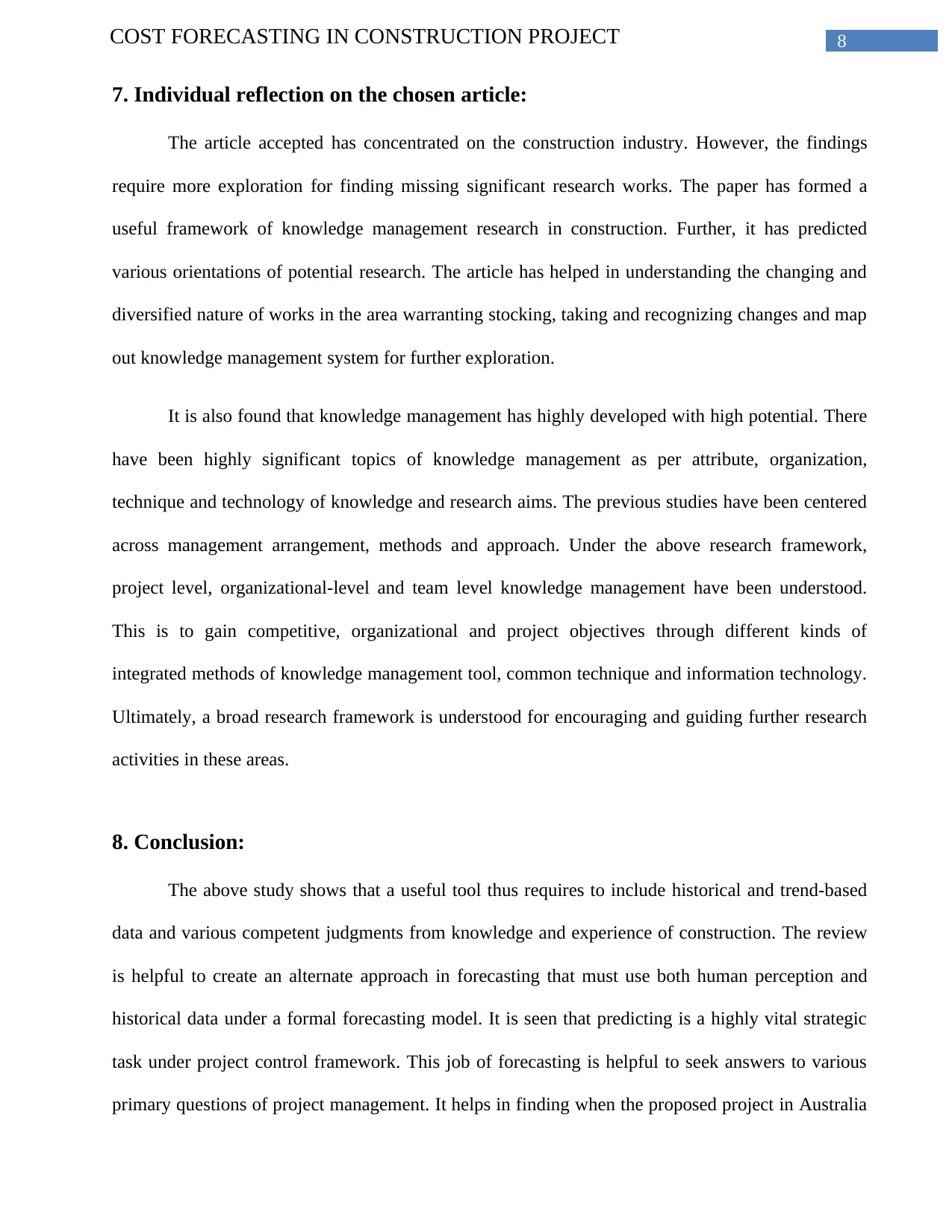
8COST FORECASTING IN CONSTRUCTION PROJECT
7. Individual reflection on the chosen article:
The article accepted has concentrated on the construction industry. However, the findings
require more exploration for finding missing significant research works. The paper has formed a
useful framework of knowledge management research in construction. Further, it has predicted
various orientations of potential research. The article has helped in understanding the changing and
diversified nature of works in the area warranting stocking, taking and recognizing changes and map
out knowledge management system for further exploration.
It is also found that knowledge management has highly developed with high potential. There
have been highly significant topics of knowledge management as per attribute, organization,
technique and technology of knowledge and research aims. The previous studies have been centered
across management arrangement, methods and approach. Under the above research framework,
project level, organizational-level and team level knowledge management have been understood.
This is to gain competitive, organizational and project objectives through different kinds of
integrated methods of knowledge management tool, common technique and information technology.
Ultimately, a broad research framework is understood for encouraging and guiding further research
activities in these areas.
8. Conclusion:
The above study shows that a useful tool thus requires to include historical and trend-based
data and various competent judgments from knowledge and experience of construction. The review
is helpful to create an alternate approach in forecasting that must use both human perception and
historical data under a formal forecasting model. It is seen that predicting is a highly vital strategic
task under project control framework. This job of forecasting is helpful to seek answers to various
primary questions of project management. It helps in finding when the proposed project in Australia
7. Individual reflection on the chosen article:
The article accepted has concentrated on the construction industry. However, the findings
require more exploration for finding missing significant research works. The paper has formed a
useful framework of knowledge management research in construction. Further, it has predicted
various orientations of potential research. The article has helped in understanding the changing and
diversified nature of works in the area warranting stocking, taking and recognizing changes and map
out knowledge management system for further exploration.
It is also found that knowledge management has highly developed with high potential. There
have been highly significant topics of knowledge management as per attribute, organization,
technique and technology of knowledge and research aims. The previous studies have been centered
across management arrangement, methods and approach. Under the above research framework,
project level, organizational-level and team level knowledge management have been understood.
This is to gain competitive, organizational and project objectives through different kinds of
integrated methods of knowledge management tool, common technique and information technology.
Ultimately, a broad research framework is understood for encouraging and guiding further research
activities in these areas.
8. Conclusion:
The above study shows that a useful tool thus requires to include historical and trend-based
data and various competent judgments from knowledge and experience of construction. The review
is helpful to create an alternate approach in forecasting that must use both human perception and
historical data under a formal forecasting model. It is seen that predicting is a highly vital strategic
task under project control framework. This job of forecasting is helpful to seek answers to various
primary questions of project management. It helps in finding when the proposed project in Australia
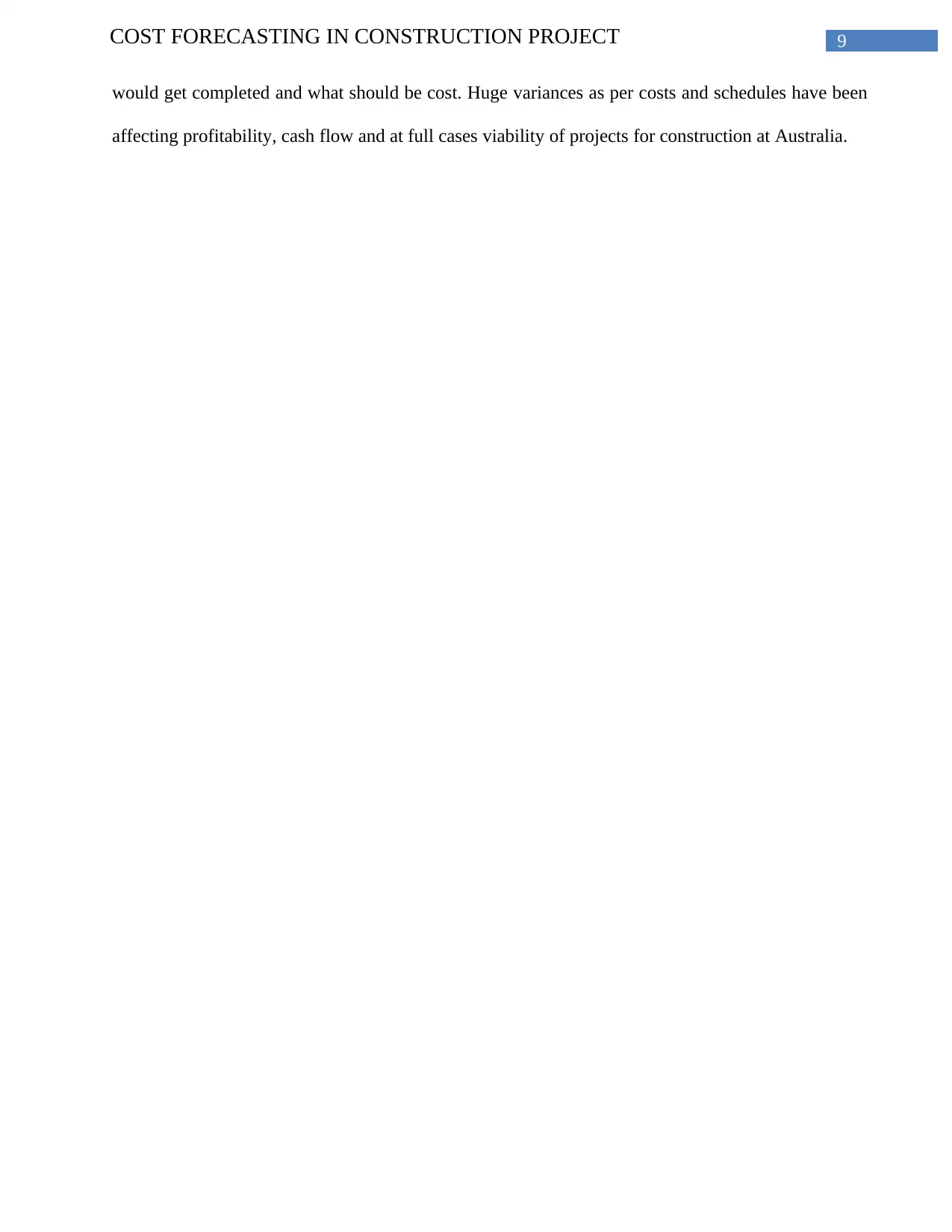
9COST FORECASTING IN CONSTRUCTION PROJECT
would get completed and what should be cost. Huge variances as per costs and schedules have been
affecting profitability, cash flow and at full cases viability of projects for construction at Australia.
would get completed and what should be cost. Huge variances as per costs and schedules have been
affecting profitability, cash flow and at full cases viability of projects for construction at Australia.
Secure Best Marks with AI Grader
Need help grading? Try our AI Grader for instant feedback on your assignments.
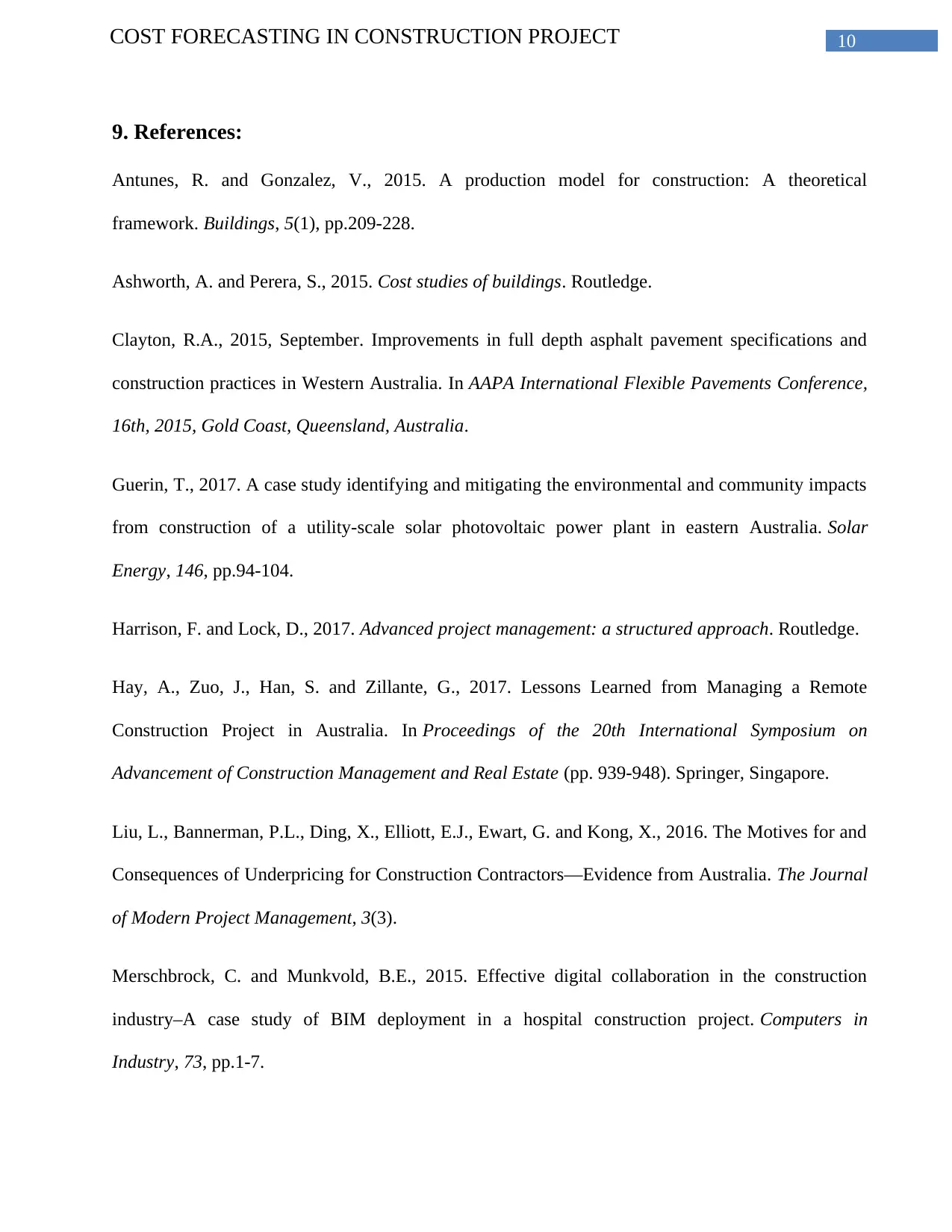
10COST FORECASTING IN CONSTRUCTION PROJECT
9. References:
Antunes, R. and Gonzalez, V., 2015. A production model for construction: A theoretical
framework. Buildings, 5(1), pp.209-228.
Ashworth, A. and Perera, S., 2015. Cost studies of buildings. Routledge.
Clayton, R.A., 2015, September. Improvements in full depth asphalt pavement specifications and
construction practices in Western Australia. In AAPA International Flexible Pavements Conference,
16th, 2015, Gold Coast, Queensland, Australia.
Guerin, T., 2017. A case study identifying and mitigating the environmental and community impacts
from construction of a utility-scale solar photovoltaic power plant in eastern Australia. Solar
Energy, 146, pp.94-104.
Harrison, F. and Lock, D., 2017. Advanced project management: a structured approach. Routledge.
Hay, A., Zuo, J., Han, S. and Zillante, G., 2017. Lessons Learned from Managing a Remote
Construction Project in Australia. In Proceedings of the 20th International Symposium on
Advancement of Construction Management and Real Estate (pp. 939-948). Springer, Singapore.
Liu, L., Bannerman, P.L., Ding, X., Elliott, E.J., Ewart, G. and Kong, X., 2016. The Motives for and
Consequences of Underpricing for Construction Contractors—Evidence from Australia. The Journal
of Modern Project Management, 3(3).
Merschbrock, C. and Munkvold, B.E., 2015. Effective digital collaboration in the construction
industry–A case study of BIM deployment in a hospital construction project. Computers in
Industry, 73, pp.1-7.
9. References:
Antunes, R. and Gonzalez, V., 2015. A production model for construction: A theoretical
framework. Buildings, 5(1), pp.209-228.
Ashworth, A. and Perera, S., 2015. Cost studies of buildings. Routledge.
Clayton, R.A., 2015, September. Improvements in full depth asphalt pavement specifications and
construction practices in Western Australia. In AAPA International Flexible Pavements Conference,
16th, 2015, Gold Coast, Queensland, Australia.
Guerin, T., 2017. A case study identifying and mitigating the environmental and community impacts
from construction of a utility-scale solar photovoltaic power plant in eastern Australia. Solar
Energy, 146, pp.94-104.
Harrison, F. and Lock, D., 2017. Advanced project management: a structured approach. Routledge.
Hay, A., Zuo, J., Han, S. and Zillante, G., 2017. Lessons Learned from Managing a Remote
Construction Project in Australia. In Proceedings of the 20th International Symposium on
Advancement of Construction Management and Real Estate (pp. 939-948). Springer, Singapore.
Liu, L., Bannerman, P.L., Ding, X., Elliott, E.J., Ewart, G. and Kong, X., 2016. The Motives for and
Consequences of Underpricing for Construction Contractors—Evidence from Australia. The Journal
of Modern Project Management, 3(3).
Merschbrock, C. and Munkvold, B.E., 2015. Effective digital collaboration in the construction
industry–A case study of BIM deployment in a hospital construction project. Computers in
Industry, 73, pp.1-7.
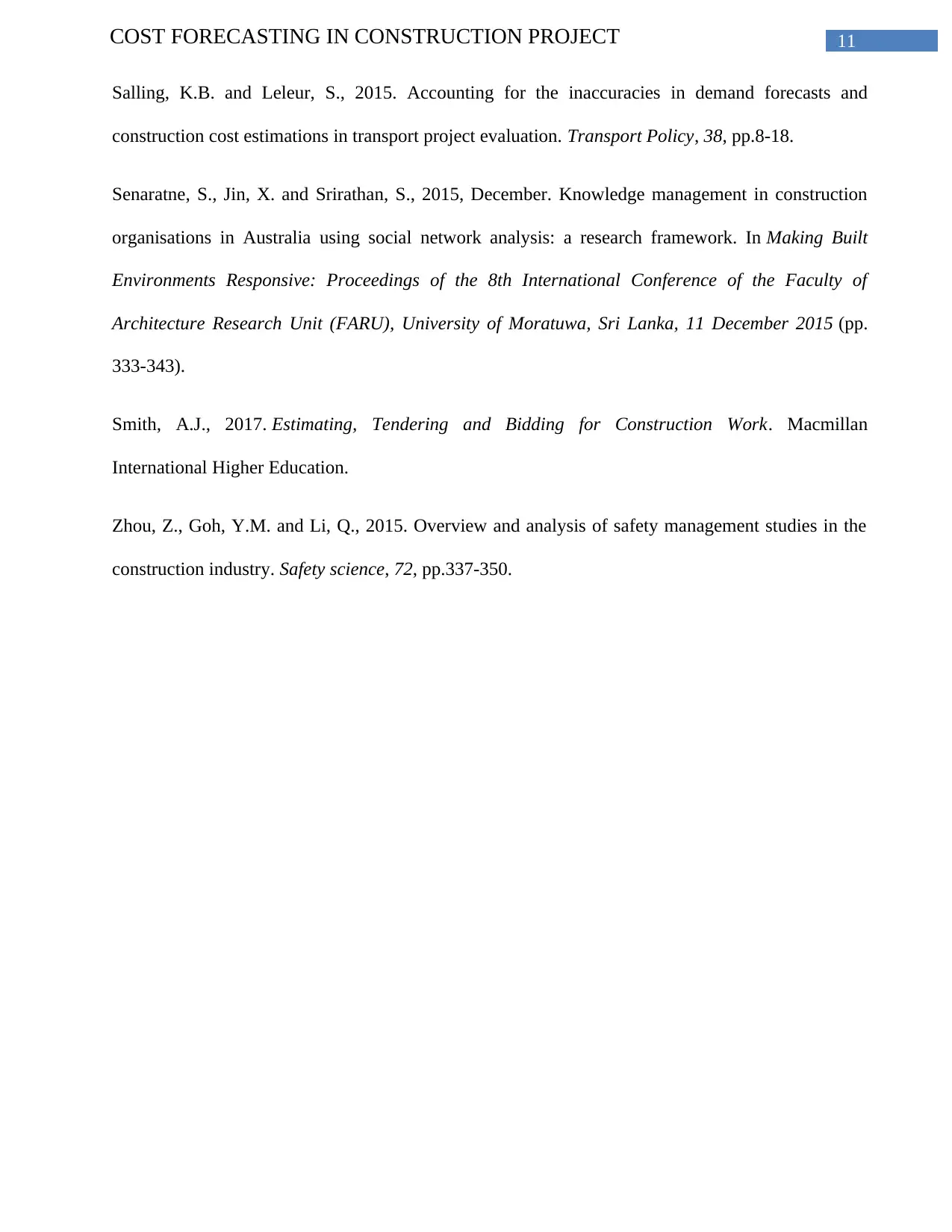
11COST FORECASTING IN CONSTRUCTION PROJECT
Salling, K.B. and Leleur, S., 2015. Accounting for the inaccuracies in demand forecasts and
construction cost estimations in transport project evaluation. Transport Policy, 38, pp.8-18.
Senaratne, S., Jin, X. and Srirathan, S., 2015, December. Knowledge management in construction
organisations in Australia using social network analysis: a research framework. In Making Built
Environments Responsive: Proceedings of the 8th International Conference of the Faculty of
Architecture Research Unit (FARU), University of Moratuwa, Sri Lanka, 11 December 2015 (pp.
333-343).
Smith, A.J., 2017. Estimating, Tendering and Bidding for Construction Work. Macmillan
International Higher Education.
Zhou, Z., Goh, Y.M. and Li, Q., 2015. Overview and analysis of safety management studies in the
construction industry. Safety science, 72, pp.337-350.
Salling, K.B. and Leleur, S., 2015. Accounting for the inaccuracies in demand forecasts and
construction cost estimations in transport project evaluation. Transport Policy, 38, pp.8-18.
Senaratne, S., Jin, X. and Srirathan, S., 2015, December. Knowledge management in construction
organisations in Australia using social network analysis: a research framework. In Making Built
Environments Responsive: Proceedings of the 8th International Conference of the Faculty of
Architecture Research Unit (FARU), University of Moratuwa, Sri Lanka, 11 December 2015 (pp.
333-343).
Smith, A.J., 2017. Estimating, Tendering and Bidding for Construction Work. Macmillan
International Higher Education.
Zhou, Z., Goh, Y.M. and Li, Q., 2015. Overview and analysis of safety management studies in the
construction industry. Safety science, 72, pp.337-350.
1 out of 12
Related Documents
Your All-in-One AI-Powered Toolkit for Academic Success.
+13062052269
info@desklib.com
Available 24*7 on WhatsApp / Email
![[object Object]](/_next/static/media/star-bottom.7253800d.svg)
Unlock your academic potential
© 2024 | Zucol Services PVT LTD | All rights reserved.




